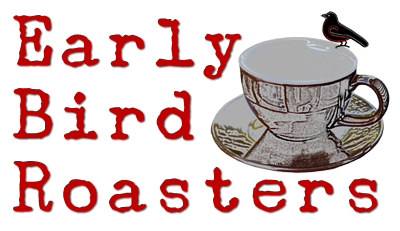
Whole Bean - Micro Batch Roasted
Coffee Blends and Sourced Origins Change seasonally . . . .
Like wine, coffee varietals are here today, gone tomorrow. Each batch of beans are selected for their documented processing, quality, region and history. Once I receive them, I run them through various roast profiles until I find the perfect match of roast to bean. The flavor complexities are numerous, and variables endless. . . . that is in great part why coffee roasting is so fun!
Note that the green beans are typically purchased in satchels that weigh in at 50-65 lbs. Thus, once a varietal or select bean is gone, it’s usually gone forever. But the good news is there’s almost always something that will equally replace it, similar, but different.
Price differences in the beans do not always reflect quality of the beans, some regions price differently based on labor laws or tariffs, etc. In general, every satchel purchased by Early Bird Roasters is researched and grabbed based on many criteria, but at the very top of the list is quality, fair trade, and the story behind the bean. Sustainable profitability for the producers is vital to the market, and only 17% of all coffee produced is cetegorized as such.
Many times, the actual taste is not known until it shows up and goes through multiple iterations of testing. If for some reason I’m not getting what I’m looking for, I blend it with a complimentary bean until I score a winning cup. Thus, you will find a blend or two in my portfolio that typically contain two different, but complimenting, high quality beans.
I list brewing products on the 'Square' purchase portal as well. Not as much to sell them but make you aware of them as these are products I personally would use (or do use on a daily basis). Most products are available direct from Amazon.

In order to produce a consistent quality cup of coffee, the equipment being used can reach the specs as listed in the ‘coffee making’ pages of this site. Outside of that, the equipment does not need to be big-ticket items. If you are going to invest money into coffee, quality beans and a quality grinder are the #1 place to start. If convenience AND super good coffee is your target: a Super-Auto coffee machine loaded up with my beans . . . . will indeed be the holy grail of a cup of java!
A couple of handy tools to use in testing is a digital instant read thermometer, and a kitchen scale that get's down to a tenth of a gram. Both tools extend well beyond coffee.
The big roasters make coffee in big machines with an eye on economies of scale. Big roasters use ‘methods’ to help beans be consumable weeks after they roasted as they sit in warehouses, transportation, and the shelves of your local distribution point (supermarket, coffee house, etc.). Roasted beans have an ideal life of 2-weeks, with a good life of 4-weeks post roasting. I am not going to diss the big roasters out there as they are successful for a reason. But if you are into good coffee, it’s all the reason to move to small, micro-batch roasted beans; beans that are meticulously roasted FOR YOU, and go from roaster to your doorstep in days, not weeks or months.
Once you tweak your setup at home, whether k-cup, or super automatics, you can easily have a convenient, fast method of coffee at your fingertip’s day after day. Or mix it up, for a variety. I personally use French press on weekends, and super automatic M-F. I have friends that are 100% K-Cup at 14.4g of fresh ground beans per mug. . . . It’s all GREAT tasting coffee with fresh roasted beans.
Why do I spend hours upon hours targeting the ‘perfect’ roast? Well, because I like drinking the perfect roast. From there, sharing my findings is the easy part.